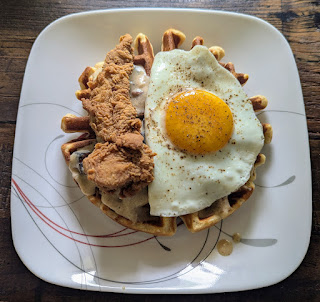This is an interesting cake. It is basically a very rich, moist chocolate cake that is "iced" with chocolate pudding rather than a buttercream or ganache or some more traditional cake coating. It is baked as two 20cm (8") round layers, each of which are then split. Three of the resulting thin layers are used to assemble the cake and the fourth is crumbled and used to coat the outside.
I didn't get my batter divided quite evenly and one of my layers baked up a little thinner than the other. I was a bit nervous about trying to split the thinner one, so I just left it whole and split the thicker one only. I then stacked two of the resulting layers and crumbled the third. This, of course, resulted in a reduced overall surface area, so the filling and "icing" are somewhat more generous than they're really meant to be. (Same overall proportions, of course, just thicker layers since there are fewer of them.)
This worked fine, but did mean that the cake was a little more... wobbly than it would have been had I made it with the "correct" number of layers.
Honestly, if I had two 18cm (7") round pans, then I'd be tempted to bake my cake in
those next time. The 8" layers baked up fine. But I would've felt more confident about splitting them had they been slightly thicker. I think 6" layers would probably be
too thick/tall. But 7" might be just about right. Sadly, I only have one 7" pan at the moment. Which still might be worth trying next time. It just makes it slightly more difficult to get the batter divided evenly and, obviously, ends up requiring double the cooking time since you have to bake the layers one after the other rather than in tandem. So, possibly something to consider, but definitely not ideal.
Other than my lack of confidence in splitting the layers though, this recipe worked out great! The cake was delicious and moist with deep chocolate flavour. (Which the coffee and brown sugar help to accentuate.) And the pudding was also pleasingly rich and thick. A winner all 'round!
Chocolate Blackout Cake
Slightly adapted from The Perfect Cake by America's Test Kitchen
Ingredients
Pudding
- 1 c. heavy (35%) cream
- 2 c. milk
- 1 1/4 c. sugar
- 1/4 c. cornstarch (cornflour)
- 1/4 tsp. coarse sea salt
- 170g unsweetened chocolate
- 2 tsp. vanilla extract
Cake
- 110g all-purpose flour
- 2 tsp. baking powder
- 1/2 tsp. baking soda
- 1/4 tsp. coarse sea salt, ground
- 1/2 c. unsalted butter
- 3/4 c. Dutched (alkalized) cocoa powder
- 1 c. brewed coffee
- 1 c. buttermilk
- 1 c. brown sugar
- 1 c. sugar
- 2 large eggs
- 1 tsp. vanilla extract
Directions
- Combine cream, milk, sugar, cornstarch, and sea salt over medium heat.
- Break chocolate into pieces and add to milk mixture.
- Cook, whisking frequently, until chocolate has completely melted and mixture is smooth and homogenous.
- Continue cooking until bubbles begin to form and pudding thickens.
- Remove from heat, stir in the vanilla, and set aside to cool.
- Chill for at least 3-4 hours.
- Meanwhile, preheat the oven to 160°C (325°F) and grease and flour1 two 20cm (8") round baking tins.
- Sift together the flour, baking powder, and baking soda.
- Mix in the salt.
- Melt the butter over medium heat.
- Mix in the cocoa and cook for 1 minute.
- Remove from heat and stir in the coffee and buttermilk.
- Add the brown sugar and granulated sugar.
- Mix in the eggs, one at a time.
- Mix in the vanilla.
- Divide the batter as evenly as possible between the prepared tins.
- Bake at 160°C (325°F) for 30-35 minutes.
- Transfer cake layers (still in their tins) to a cooling rack and allow to cool for 15 minutes.
- Invert tins onto cooling racks and carefully remove the cakes from their tins. Allow to cool completely (1-2 hours).
- Once cake layers are completely cool, divide each one horizontally.2
- Place one layer on a serving platter.
- Spoon ~1 c. of pudding on top and spread all the way to the edges of the layer.
- Top with a second layer and repeat the process: spreading 1 c. of putting on top.
- Place a third layer on top and spoon the rest of the pudding over it, completely covering the entire cake -- top and sides.
- Crumble the fourth layer and sprinkle the chocolate crumbs on top of your assembled cake, covering the top and sides. You will have to press slightly to get the crumbs to adhere to the pudding. Especially on the sides of the cake.
- Serve immediate or refridgerate for up to 2 days.
You may wish to line the bottoms with parchment paper and grease the paper before flouring. This adds an extra step, but will help ensure that the cake relases from the pans cleanly.
Back
The folks at America's test kitchen recommend doing this with a serrated knife. The outline a procedure of scoring the perimeter of the cake layers and then cutting through along the scored lines to get a level split. Personally, I have always preferred my mother's method of using a piece of thread. You simply take a long piece of thread and wrap it around the cake (doing your best to make sure it's roughly level/even all the way around), then grab both ends and pull tightly. The thread should slice neatly through the cake! I've found it a ver quick and reliable method and prefer it to faffing about with knives or cake levelling contraptions.
Back

























